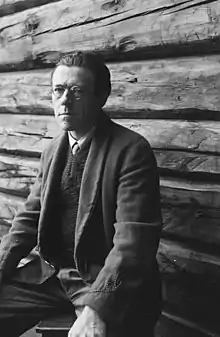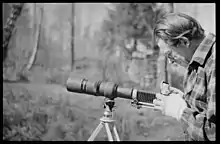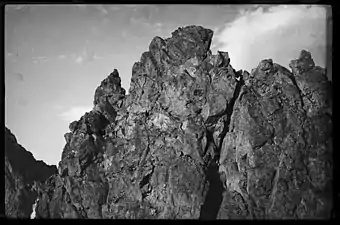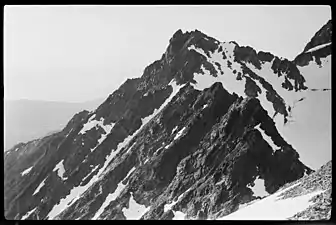Peter Wessel Zapffe | |
|---|---|
 Zapffe in 1949 | |
| Born | 18 December 1899 Tromsø, Norway |
| Died | 12 October 1990 (aged 90) Asker, Norway |
| Alma mater | University of Oslo |
| Occupation(s) | Philosopher, author, artist, lawyer, mountaineer |
| Notable work |
|
| Spouses | Bergliot Espolin Johnson
(m. 1935; div. 1941)Berit Riis Christensen
(m. 1952) |
| Awards | Fritt Ord Honorary Award (1987)[1] |
| Era | 20th-century philosophy |
| School | |
| Language | Norwegian |
Main interests | Metaphysics, nihilism, philosophical pessimism |
Notable ideas |
|
Peter Wessel Zapffe (18 December 1899 – 12 October 1990) was a Norwegian philosopher, author, artist, lawyer and mountaineer. He is often noted for his philosophically pessimistic and fatalistic view of human existence.[2] His system of philosophy was inspired by the German philosopher Arthur Schopenhauer, as well as his firm advocacy of antinatalism.[3] His thoughts regarding the error of human life are presented in the essay "The Last Messiah" ("Den sidste Messias", 1933).[4] This essay is a shorter version of his best-known and untranslated work, the philosophical treatise On the Tragic (Om det tragiske, 1941).[2]
Philosophical work
Zapffe's view is that humans are born with an overdeveloped skill (understanding, self-knowledge) which does not fit into nature's design. The human craving for justification on matters such as life and death cannot be satisfied, hence humanity has a need that nature cannot satisfy. The tragedy, following this theory, is that humans spend all their time trying not to be human. The human being, therefore, is a paradox.
In "The Last Messiah", Zapffe described four principal defense mechanisms that humankind uses to avoid facing this paradox:
- Isolation is "a fully arbitrary dismissal from consciousness of all disturbing and destructive thought and feeling".[5]
- Anchoring is the "fixation of points within, or construction of walls around, the liquid fray of consciousness".[5] The anchoring mechanism provides individuals with a value or an ideal to consistently focus their attention on. Zapffe also applied the anchoring principle to society and stated that "God, the Church, the State, morality, fate, the laws of life, the people, the future"[5] are all examples of collective primary anchoring firmaments.
- Distraction is when "one limits attention to the critical bounds by constantly enthralling it with impressions".[5] Distraction focuses all of one's energy on a task or idea to prevent the mind from turning in on itself.
- Sublimation is the refocusing of energy away from negative outlets, toward positive ones. The individuals distance themselves and look at their existence from an aesthetic point of view (e.g., writers, poets, painters). Zapffe himself pointed out that his produced works were the product of sublimation.
On the occasion of the 65th birthday of the Norwegian–Canadian philosopher Herman Tønnessen, the book I Choose the Truth. A Dialogue Between Peter Wessel Zapffe and Herman Tønnessen (1983) was published. The two had known each other already for many years. Tønnessen had studied at the University of Oslo together with Arne Næss.[6]
Other interests and works
Zapffe was a prolific mountaineer and took a very early interest in environmentalism; this form of nature conservationism sprung from the intent, not of protecting nature, but to avoid human culturalization of nature.[7]
Zapffe was the author of many humorous short stories about climbing and other adventures in nature.[8]
Personal life
Son of the apothecary Fritz Gottlieb Zapffe and Gudrun Wessel, Zapffe was related on his maternal side to the Danish-Norwegian admiral Peter Tordenskjold.[6]
In Kristiania, in 1921, Zapffe learned for the first time about mountaineering, beginning with climbing challenges in Bærum, in Kolsås, the first mountain he climbed. In 1924 he was the first person to climb the top of Tommeltott in Ullsfjorden; in 1925, the Småting (south side) in Kvaløya; and the Bentsjordtind between Malangen and Balsfjorden. And in the same year: Okshorn, Snekollen and Mykkjetind were climbed. In 1926 it was a summit in Senja and also the Hollenderan summit in Kvaløya, first trodden by him: in 1987 the highest peak of the Hollenderan in Kvaløya was named after him. Today the summit is called "Zapffes tind" ('the top of Zapffe'). In 1928, Zapffe climbed the first summit of Skamtinden and was also the first to climb the front side of Svolværgeita.[6]
In 1940 Zapffe applied to the Norsk Tindeklubb but was rejected. However, in 1965 he was accepted into a mountaineering society but as an honorary member, and again in 1987 in a mountaineering club from Tromsø.[6]
In 1928, due to a storm, Umberto Nobile's zeppelin, the Italia, crashed on the way back to Italy. Roald Amundsen (a friend of the Zapffe family) and Zapffe assisted in the rescue of the zeppelin crew. There, Zappfe served as interpreter for the expedition. Later on the icebreaker DS «Isbjørn», Zapffe served as German interpreter, his father was also on board: the expedition was then to search for the missing Amundsen, but was unsuccessful.
Zapffe left Tromsø on June 5, 1929. He found a room on Erling Skjalgssøns street in Kristiania, living quite frugally and in a mentally catastrophic state: "The idea of death as the greatest consolation and escape, and which is always at hand, penetrates me with even greater force".[6]
Similar to Emil Cioran, he lived from 1978 on a state pension. In 1987 he received the Honor Award from the Fritt Ord Foundation for "the original and versatile character of his literary work".[6]
In his last years of life, when he was frequently visited by journalists, he had an interview with Asker og Bærum Budstikke, in which he described himself as a nihilist: "I am not a pessimist. I am a nihilist. Namely, not a pessimist in the sense that I have upsetting apprehensions, but a nihilist in a sense that is not moral".[6]

Zapffe's hobbies were varied, showing an early enthusiasm for painting. However, photography occupied him since the age of 12 through his father (himself a photographer), who lent his photographic equipment to his son. This also meant a kind of compensation for his myopia. The impact of his work as a photographer can be seen reflected in his work Rough Joys (1969), where it seems that he reconstructs ekphrase from his photographic documentation during his trips to the mountains. Much of his photographic production is currently cultural heritage.[6]
Zapffe married Bergljot Espolin Johnsen in 1935; they divorced in 1941. He married Berit Riis Christensen in 1952, they remained together until his death in 1990; Berit died in May 2008.[9] Zapffe remained childless by choice.[10] He was lifelong friends with the Norwegian philosopher and fellow mountaineer, Arne Næss.[1]
Selected works
- Om det tragiske (En: On the Tragic), Oslo, 1941 and 1983.
- Den fortapte sønn. En dramatisk gjenfortælling (En: The Prodigal Son: A Dramatic Renarration), Oslo, 1951.
- Indføring i litterær dramaturgi (En: Introduction to Literary Dramaturgy), Oslo, 1961.
- Den logiske sandkasse. Elementær logikk for universitet og selvstudium (En: The Logical Sandpit: Elementary Logic for University and Individual Study), Oslo, 1965.
- Lyksalig pinsefest. Fire samtaler med Jørgen (En: Blissful Pentecost: Four Dialogues with Jørgen), Oslo, 1972.
- Hos doktor Wangel. En alvorlig spøk i fem akter (En: With Doctor Wangel: An Earnest Jest in Five Acts), by Ib Henriksen (pseudonym.), Oslo, 1974. Play.
- Rikets hemmelighet. En kortfattet Jesus-biografi (En: The Secret of the Kingdom: A Short Biography of Jesus), Oslo, 1985.
Collections of his shorter writings
- Essays og epistler (En: Essays and epistles), Oslo, 1967.
- Barske glæder og andre temaer fra et liv under åpen himmel (En: Rough Joys, and other themes from a life lived under the open sky), Oslo 1969.
- Spøk og alvor. Epistler og leilighetsvers (En: Jest and Earnest: epistles and occasional verse), Oslo, 1977.
- Hvordan jeg blev så flink og andre tekster (En: How I Became So Clever, and other texts), Oslo, 1986.
- Vett og uvett. Stubber fra Troms og Nordland (En: Sense and Nonsense: Short Stories from Troms and Nordland) by Einar K. Aas and P. W. Zapffe, Trondheim 1942. Illustrated by Kaare Espolin Johnson.
Gallery
 Jægervatnet c. 1945
Jægervatnet c. 1945 Jægervatnet c. 1945
Jægervatnet c. 1945_by_Peter_Wessel_Zapffe.jpg.webp) Silhouettes of people c. 1950
Silhouettes of people c. 1950
See also
Notes
- 1 2 "Biography of Peter Wessel Zapffe". Open Air Philosophy. Retrieved 7 August 2020.
- 1 2 Tangenes, Gisle R. (March–April 2004). "The View from Mount Zapffe". Philosophy Now. Retrieved 12 April 2020.
- ↑ Zapffe remarked that children are brought into the world without consent or forethought: "In accordance with my conception of life, I have chosen not to bring children into the world. A coin is examined, and only after careful deliberation, given to a beggar, whereas a child is flung out into the cosmic brutality without hesitation." The Humorous Pessimist (1990 documentary, subtitled in English) by NRK, 32:18-32:44. Original source (in Norwegian).
- ↑ Zapffe, P.W. (25 November 2016). "The Last Messiah". After us.
- 1 2 3 4 Zapffe, Peter Wessel (March–April 2004). "The Last Messiah". Philosophy Now. Retrieved 12 April 2020.
- 1 2 3 4 5 6 7 8 Haave, Jørgen (1999). Naken under kosmos: Peter Wessel Zapffe, en biografi. Oslo: Pax. ISBN 82-530-2117-8. OCLC 44854528.
- ↑ Zapffe, Peter Wessel (1969). "Parting with Gausta" (PDF). Open Air Philosophy.
- ↑ Zapffe, Peter Wessel (1937). "Stetind" (PDF). Open Air Philosophy.
- ↑ "Peter Wessel Zapffe". Hemneslekt. Archived from the original on 8 October 2021. Retrieved 7 August 2020.
- ↑ Reed, Peter; Rothenberg, David, eds. (1993). "Peter Wessel Zapffe". Wisdom in the Open Air: The Norwegian Roots of Deep Ecology. Minneapolis, Minnesota: University of Minnesota Press. p. 56. ISBN 978-0-8166-2150-7.
External links
- Norwegian Pessimistic Anti-Natalism by Ole Martin Moen, 2022
- Philosopher of tragedy by Thomas Hylland Eriksen
- The View from Mount Zapffe by Gisle Tangenes
- The Humorous Pessimist (1990 documentary, subtitled in English) by NRK. Original source (in Norwegian).
- Peter Wessel Zapffes fotografier til Nasjonalbiblioteket
- University of Oslo
- University of the Arctic
- Family genealogy
- OpenAirPhilosophy
._1937._Tysfjord%252C_Stetind.jpg.webp)